For some time now, I have been intrigued by the design specifications of the Batman Beyond suit (http://dcanimated.wikia.com/wiki/Terry_McGinnis%27s_Batsuit).
Moreover, I see the suit as being the apex in suit armor design ever created by the billionaire industrialist, Bruce Wayne (http://batman.wikia.com/wiki/Batman and http://dcanimated.wikia.com/wiki/Batman), of Wayne Enterprises (http://en.wikipedia.org/wiki/Wayne_Enterprises), to assist him in his ongoing war on crime as the Dark Knight.
But where did Wayne get the idea to create the Batman Beyond suit?
Where did it really come from?
Now from the “Terry McGinnis’s Batsuit” link, the reader is told the history of the suit:
“This high-tech Batsuit was developed presumably to compensate for Bruce Wayne’s advancing age and eventually passed on to Terry McGinnis became Gotham’s new savior.[2] Despite being 30 years old,[3] its technology was so advanced that the Suit was still considered state of the art.
“It is largely unknown what Bruce used to build the Suit, except that he got its servo-motors from Dr. Peter Corso.[4] Bruce combined and incorporated most of the features and concepts of previous costumes and other gadgets into this Suit, such as the flight capability of the Jet-Wing,[5] batarangs with auxiliary functions, grappling guns, bolas, and retractable claws,[6] among other things. It also gave the wearer superhuman strength, agility, and flexibility. He also built in new features such as a cloaking device—possibly inspired by the light refractive polymer[7]—although this function probably consumed a good deal of the Suit’s power, seeing as Terry minimized its usage. With this Suit, Batman had more versatility, as he was less dependent on portable gadgets, as well as less vulnerable to external adversities. The entire costume was an exoskeleton of electronic circuits; however, it was malleable like regular clothing, capable of being folded to fit inside Terry’s backpack.[8] Moreover, it conformed to the size of its wearer, seeing as it was able to fit both Bruce[9]and Terry as they have different physiques at the time. Its external cloth was also somewhat resistant, still it could be torn off, thus exposing the Suit’s circuitry.[10]“
The mystery that has yet to be answered is “what Bruce used to build the suit”?
We know why he created the suit, we just don’t know where he got the idea to create it from?
I have a theory that might help answer where he attained the knowledge, and the means, to create the suit.
From this theory the reader will discover there were, in fact, three other prototype suits secretly created and tested.
The history of the Batman Beyond suit worn by Bruce Wayne, and his genetic son, Terry McGinnis (https://dcanimated.wikia.com/wiki/Batman_(Terry_McGinnis) ) (see JUSTICE LEAGUE UNLIMITED episode, EPILOGUE, for details) has its origins in the aftermath of the two ARMOR WARS (http://en.wikipedia.org/wiki/Armor_Wars) fought by billionaire industrialist, Tony Stark (http://en.wikipedia.org/wiki/Iron_Man), of Stark Enterprises (http://en.wikipedia.org/wiki/Stark_Enterprises) to regain every item of Iron Man armor technology that had been stolen from him and used on the black market to create deadlier and opposing versions of the Iron Man suits (http://en.wikipedia.org/wiki/Iron_Man’s_armor) worn by Mr. Stark.
Stark did his best to get every item back in his possession. However, word got around that Iron Man was once again battling armored suited opponents to get back what was his, and the attention of these conflicts made their way to Mr. Wayne. Soon after, Wayne intentionally sought out defense contracts that would put him in close proximity to Stark Enterprises, in hopes of not outbidding them, but to create joint partnerships where Stark and Wayne could pull resources and materials to complete assigned tasked put forth by the Department of Defense.
Eventually, Wayne and Stark entered into a joint partnership to create a state-of-the-art next generation stealth suit application for the Force 21st century armor being funded and created by DARPA (http://en.wikipedia.org/wiki/DARPA). Both men threw themselves into the project drafting competing concepts for the suit that could aid U.S. special operations.
And in time, both men realized that a fusion of the two concepts was needed for the contract to succeed.
Therefore, Wayne and Stark met to compare notes and had a chance to size the other man up. To their surprise, despite their differences, the two men had a lot in common. And both were not who they appeared to be.
During this meeting, Stark was using the blueprints of an abandon Stealth Iron Man armor suit (http://www.ironmanarmory.com/stealtharmor.html) that he had intended his “bodyguard” to wear, and he was trying to rework the design to fit within the parameters of the design specifications of the Force 21st century suit. Wayne used some of his skill concerning the stealth and audio capabilities to his Batman suit as well.
Unfortunately, due to budget cutbacks, the program was scrapped, and with it, the joint partnership that Wayne and Stark had entered into. Nevertheless, the brainstorming sessions had helped both men in creating better suits to fight crime with. Especially, when it concerns the later research conducted by Wayne.
Wayne’s first foray in armored suit technology occurred soon after regaining the mantle of Batman, after he had temporarily relinquished it to Jean-Paul Valley, a university graduate student of computer science, who had redesigned the traditional Batsuit to make it an amalgamation of the Batman and Iron Man suits.
Valley had played a pivotal role in the “Knightfall” story-arc (1993–1994), in which he stood in as Batman after Wayne was defeated and paralyzed at the hands of the notorious super-criminal, Bane.
Upon recovering from his injury, Wayne challenged Valley to regain the title of Batman, and he won. Despite the fact that Wayne would revert back to the classic Batsuit, he was impressed by the capabilities of Valley’s suit and saw a use for it in the foreseeable future.
However, as time went on, Wayne knew that in order to thrive in his war against the numerous criminal elements, he would have to change with the times, and develop better Batsuits to help him accomplish his missions.
He remembered the design specifications of the scrapped Iron Man Stealth Armor suit that was in one of Stark’s blueprints during their meeting, and had, in fact, taken a picture of the blueprint using a silent miniature microfilm camera in his wristwatch created by his vice president of special projects, Lucius Fox (http://batman.wikia.com/wiki/Lucius_Fox).
And from this bit of industrial espionage, Wayne was able to download the specs to his Batcave computer system, and he looked at the suit in great detail, creating 3-D virtual holographic presentations of the armored suit, and figuring out how he could adapt it as a next generation Batsuit.
As the years progressed, Wayne and Fox developed a pseudo-organic metallic compound that acted like an “organic armor” that used its nanomachines to create whatever device it was programmed to make.
Wayne used this compound to create the first prototype Batsuit for program, Batman 2.0.
Wayne then tested the suit to see how far he could push it.
And inadvertently aroused the suspicions of Lucius Fox, and his son, Lucas, who might have seen the suit in flight on his way home one night.
Inspired by what he saw, and being a gifted scientist, engineer, and inventor, Lucius Fox developed his own armored Batsuit several years later, that later became the second Batwing suit, and perhaps Lucius obtained a copy of the Batman 2.0 specs, and in time, his equally gifted son, Lucas, was able to upgrade the Batwing suit inside his own basement laboratory.
It is from the second Batwing armored suit that the early beginnings of the Batman Beyond armored suit emerge.
http://worldofblackheroes.files.wordpress.com/2013/04/luke-fox5.jpg?w=855&h=1299
Batwing Suit:
http://dc.wikia.com/wiki/Batwing_Suit
And as Bruce Wayne returned to the public eye after coming back from an indeterminate period of seclusion, Bruce established Batman Incorporated (http://dc.wikia.com/wiki/Batman_Incorporated), an organization that expanded the reach of the Dark Knight, and his allies, and soon after, recruits Lucas Fox, the new Batwing, as a member of Batman Incorporated.
This recruitment served two purposes:
1) To watch over, protect, and train the son of one of his oldest and dearest friends and colleagues;
2) To observe what Lucas and Lucius have done with his original Batman 2.0 research, and to reverse engineer the process to establish what will later become known as the Batman Beyond project with Dr. Peter Corso.
As time moved on, Lucas Fox used his financial, technical, and tactical skills to establish his own high tech firm that eventually becomes a powerhouse and competitor to Wayne Enterprises and Stark Enterprises by the time Terry McGinnis arrives on the scene and becomes the next Batman.
By this time, the Batwing armored suit has been retired by Lucas.
However, the technological advances that the Batwing suit, and its predecessors, used established a series of innovations that helped to push the science and technology of advanced armored combat suits that would later go into creating the Batman Beyond suit that an elderly Bruce Wayne, and young Terry McGinnis, would wear and used in their never-ending battle against injustice in Gotham City, and beyond.
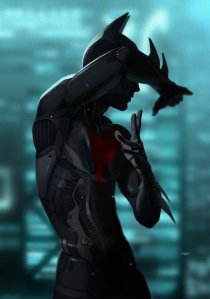
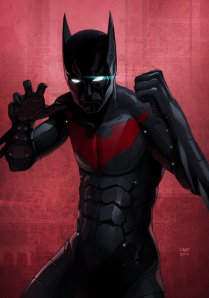

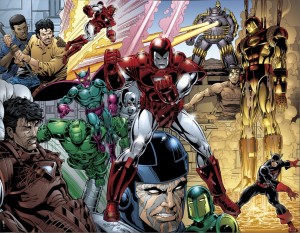
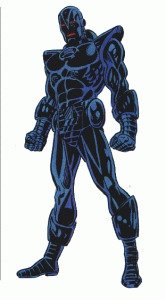
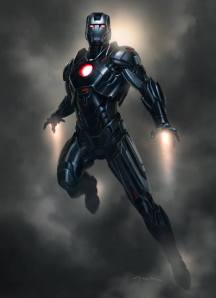
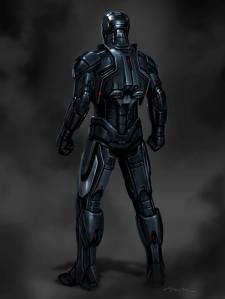
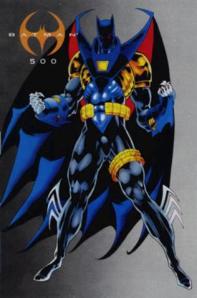
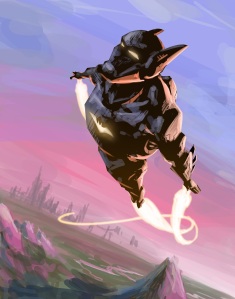




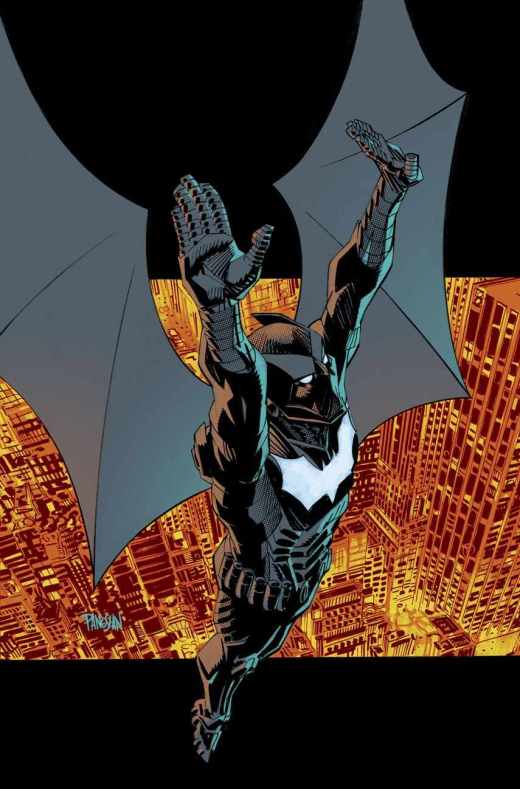

Very cool – I could see something like this being canonized as the history of the suit’s development, with Tony’s contributions only alluded to of course (which is too bad, since I love the idea of those two interacting in whatever context).
I wonder where the armor see in “The Dark Knight Returns” fits in?
Thank you, T. Everett.
That’s a great question.
The suit, perhaps much like the Batmobile, was reconfigured to deal with riot situations in Gotham City.
It’s fairly padded well, yet maneuverable.
I am definitely going to have to get back to you on that one.
It sounds like the makings of a great post in the near future.
Take care! 🙂
Man I loved all those Marvel / DC crossovers we got in the 90’s. Too bad we never got an Iron Man / Batman crossover, that would have been awesome. Cool article Garrett, I look forward to reading more.
Thank you, John.
I agree. Definitely, a missed opportunity on their part not to bring these two men of industry turned vigilantes together for at least a one-off tale. Perhaps pitting them against Ras al’Ghul and the League of Assassins, and The Mandarin and his Ten Rings secret society. Now that would have been fun to read.
Thank you for your kind words and feedback.
My apologies for the late reply.